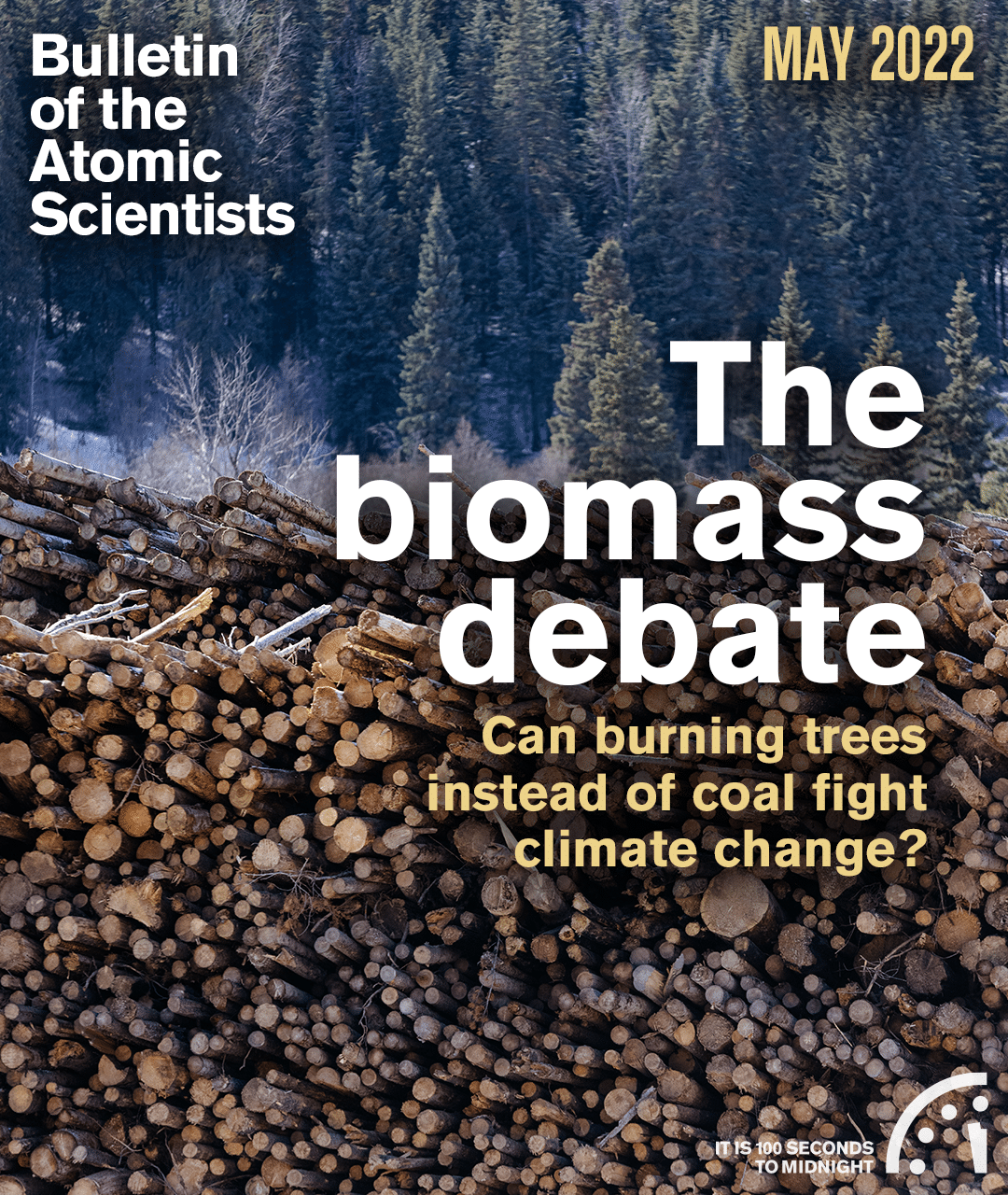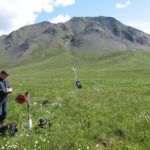Introduction: Can we grow and burn our way out of climate change?
By Dan Drollette Jr | May 10, 2022
Introduction: Can we grow and burn our way out of climate change?
By Dan Drollette Jr | May 10, 2022
To help fight climate change, the world needs to burn less coal, oil, and natural gas. The reasons are twofold: When burned, these fossil fuels emit large amounts of carbon dioxide. Also, the carbon they contain was originally formed by the decay of plants and animals that were alive before the age of the dinosaurs—hence the adjective “fossil.” During all the time that passed since they died, the carbon contained in those organisms was safely locked away deep underground—but now that it’s extracted and burned, that material becomes a fresh source of carbon in the atmosphere, one that had not been in play for millennia.
Saying that the world has to stop using fossil fuels is simple, but implementing a new energy system built largely on renewable energy is difficult, as anyone knows who follows the news from Washington, D.C.
One possible solution that has gained traction in the last decade involves replacing the burning of coal in electrical generating plants with the burning of wood—or any other kind of vegetation, including corn, sunflower stalks, grapevines, soybeans, and other forms of what is technically known as “biomass.” In the most financially successful version of this technology to date, huge swaths of forests in North America are clearcut and ground into little wood pellets that look like the dry feed available at the corner pet store. These pellets are then shipped thousands of miles across the Atlantic Ocean to generate electricity at power plants in Europe—the most well-known of which is probably the one located in the town of Drax in the United Kingdom.
Formerly one of the largest coal-burning power plants in the world, the Drax facility has been retrofitted at a cost of an estimated $1 billion to burn wood pellets. The promoters of this technology have been heavily touting Drax as the prototype of a so-called “green” way to combat climate change, claiming that the power plant merely re-uses carbon that is already in the carbon cycle rather than consuming fossilized carbon; policy makers in the UK and EU agree with them and have given Drax massive subsidies and tax write-offs. This facility is just one—albeit the biggest and most (in)famous—of several such power plants.
Intuitively, cutting down trees to burn them seems nonsensical in a climate change context. Trees are, after all, elegant, living systems that extract carbon from thin air and sequester it in solid form: wood. But the question of whether biomass burning can truly be green generates strong reactions, both pro and con. To lead off this special issue, Oxford University physics professor and Bulletin Science and Security Board member Ray Pierrehumbert lays out some of the key issues involved in replacing fossil fuel with biomass and explains what biomass burning is and why it could work—at least in theory. In his article “Plant power: Burning biomass instead of coal can help fight climate change, but only if done right,” Pierrehumbert argues that the answer to the question of whether biomass is green or not comes down to how the growing, harvesting, processing, shipping, and burning is conducted in everyday practice; the crux of the matter, he says, is that even if biomass could arguably be a win for carbon emissions, it is not easy to produce biomass in a so-called “sustainable” way.
In “Does wood bioenergy help or harm the climate?” MIT researcher John Sterman and his colleagues William Moomaw, Juliette N. Rooney-Varga, and Lori Siegel (of the Fletcher School at Tufts University, the University of Massachusetts at Lowell, and Climate Interactive, respectively) make the case that by declaring that wood biofuels are flat-out carbon neutral, the UK and EU make the faulty assumption that regrowth of the forests is predictably rapid and certain. They write: “To avoid the worst harms from climate change we must not only keep the vast majority of remaining fossil carbon in the ground, but must also keep the vast majority of the carbon in forests on the land.”
In “Sustainable biomass: A paper tiger when it comes to reducing carbon emissions,” researcher Mary Booth of the Partnership for Policy Integrity observes that burning wood emits carbon dioxide and other air pollutants, and that while trees may be “renewable,” forest ecosystems are not. Recent events make Europe’s biomass policies even more concerning, she says: “The acute need to replace Russian fossil fuels, preferably with so-called ‘green’ alternatives, could drive a catastrophic increase in forest harvesting if the EU’s renewable energy policy continues to treat woody biomass as a ‘zero carbon’ fuel, and impacts on forests are likely to intensify in any case as fossil fuel prices rise.”
An all-too-easily overlooked aspect of the biomass debate revolves around environmental justice. An analysis of 21 US wood pellet facilities that export to Europe found that they released 16,000 tons of toxic air pollutants annually, and that one-third of the facilities violated their air-quality permits. All too often, these facilities are located in “predominantly minority and lower income communities that already bear a disproportionate burden when it comes to industrial and energy infrastructure development,” Stefan Koester notes in “Burning biomass: a Drax-tic idea, and bad for environmental justice.”
Biomass burning is likely to become even more important in the future, because it is likely to play a key role in a new, highly touted, promising negative-emissions technology known as BioEnergy Carbon Capture and Storage, or BECCS—a process that could conceivably yield carbon-negative, rather than carbon-neutral, energy. Drax has publicly stated that it will eventually start using its wood-fired boilers to provide the energy for running the BECCS process, and many long-term scenarios for transitioning from today’s fossil fuel-dependent society to a future net zero society hinge on BECCS. Whether the Drax/BECCS project ultimately succeeds depends on many factors—including the indirect effects of Drax’s use of wood imported from the distant US South. In their article “When burning wood to generate energy makes climate sense,” researchers Robert Abt, Christopher Galik, and Justin Baker of North Carolina State University—a region whose fast-growing trees make it home to many tree plantations for the pellet industry—write: “At the heart of the wood energy controversy is the question of whether it ever truly makes climate sense to substitute biomass for fossil fuels… Our work has shown that the answer is a resounding ‘it depends.’ ”
Trees take a long time to grow and take carbon out of the atmosphere. Still, Michael Ter-Mikaelian of the Ontario Forest Research Institute in Canada says, simulations show that the use of biomass as a fuel can indeed be carbon-neutral. Much relies upon the nature of the initial reference frame used when creating your model of carbon uptake on forestland, he says: “One may argue that if that southern tree plantation was not harvested, it would just sit there and continue to absorb carbon from the atmosphere. But others counter that argument by saying that it’s not going to just sit there—that forest will get harvested one way or another.” The question is whether more trees are planted, and if the forest is managed with climate change in mind.
As Ray Pierrehumbert wrote in this issue’s opening essay, “[W]hen it comes to deciding whether biomass burning is good for the climate, the devil is in the details—and there are a lot of possible devils lurking in these particular details.”
Together, we make the world safer.
The Bulletin elevates expert voices above the noise. But as an independent nonprofit organization, our operations depend on the support of readers like you. Help us continue to deliver quality journalism that holds leaders accountable. Your support of our work at any level is important. In return, we promise our coverage will be understandable, influential, vigilant, solution-oriented, and fair-minded. Together we can make a difference.
Keywords: Drax, bioenergy, biomass, carbon dioxide, climate change, forestry, sustainable forestry, wood combustion
Topics: Analysis, Climate Change






















Already in the carbon cycle say the people who promote biomass burning. Once the CO2 is in the atmosphere you have a problem. Lots of solutions that are almost green. Unfortunately Mother Nature isn’t going to give us a “its almost too hot” from its almost green or “it depends”.
Promoting the idea of using biomass is what I’m doing for almost all of my life. The idea for using Biomass is not to produce the baseload for electricity but to be the link between the intermittent producers of electricity, such as solar and wind. Doing it as the link between solar and wind would be sustainable; as the baseload producer of electricity would not. Then there is also the use of the excess heat that could be used for the drying of the feedstock, heating greenhouses, assisting in the heating of closeby buildings, and storing the heat. The future… Read more »
In Europe most wood pellets are made from forestry waste, sawmill waste and recycled wood. We don’t generally cut down trees for wood pellets as they addres more valuable as wood for timber.
If you allow wood to rot it produces methane as well as CO2. Methane is a more potent ghg than CO2 and eventually brakes down to CO2. So you get a double whammy. If you burn it, then you avoid the methane stage but you do produce particulates. So it’s complicated.